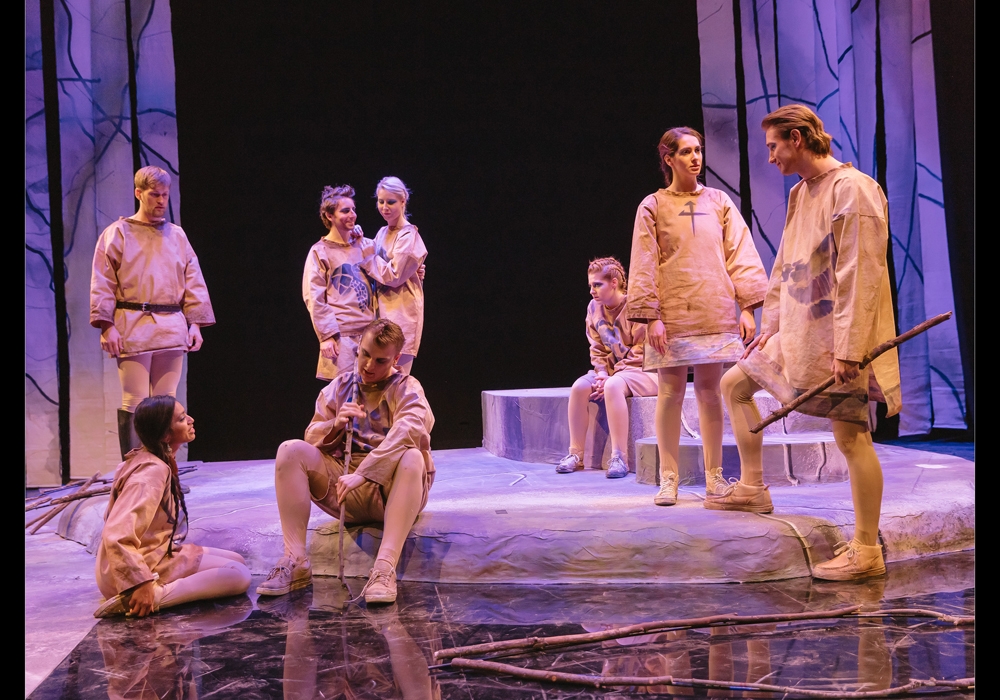Alexander Colle, Contributor
Featured image courtesy of Jeremy Mimnagh
The Department of Theatre knew what they were doing when they decided to have “performing indigeneity” as their thematic focus for the 2015-2016 season. In a country where missing and murdered indigenous women live in unlivable conditions, and apathy becomes the norm for indigenous peoples, the department cannot be accused of turning a blind eye in the face of these atrocities.
Their response? Brébeuf’s Ghost, a play published in 2000 by department alumni, current playwright, and registered Delaware Indian, Daniel David Moses. Described by him as a “tale of horror in three acts,” the story is set off of Lake Nipissing in 1649, where Christian missionaries are at war with First Nations communities. To make matters worse, Jesuit martyr Jean de Brébeuf has come back from the dead as a ghost to torment both parties.
Despite an earnest and stylized attempt to tell Moses’ epic story, the effort often succumbed to dull storytelling, resulting in a hit-and-miss rendition of the famous Canadian play.
Refreshingly, the pre-show revealed a promising introduction to the world of the play as a beautiful soundscape was audible when the audience entered the theatre. Indeed, the mix of bird calls, leaves rustling in the wind, and creaking wood created an immersive experience before the play even started. Around the walls of the black box theatre sat illuminated painted trees made out of canvas, adding to the feel of the environment. This environment complimented the main set piece quite well, a serviceable multi-platform “rock” which saw a majority of the action.
Throughout the play, these production elements held up quite well with the lighting and traditional costumes. A special kudos should be given to the aforementioned sound design, which continuously and effectively indicated what type of environment the story was set in with little distraction.
To prelude the show, our performers took centre stage, and in costume, began to introduce themselves to the audience. Sharing to the audience where they were from set up the play’s thesis quite nicely, it showed where we, as Canadians, come from.
Following a promising first act, featuring fine-pacing and performances by the fourth-year acting conservatory students, the play began to buckle under its good foundation. With dragged-on scenes and uninspired moments of emotion, the latter half of the play lacked an intriguing dynamic between characters and plot.
Fortunately, this dynamic found an exciting rhythm once a disturbing cannibalistic antagonist eventually revealed himself. Scenes featuring this character contained a sinister tone and finally gave the audience someone to root against. Between these scenes, however, lacked the slow-burning anticipation that was aimed for, which is necessary for a play that nears two and a half hours in length.
Despite this, the play successfully found moments of genuine artwork, utilizing indigenous drums, clothing, and dance to tell the story through traditional music and dance. Among these moments was a surprising indigenous dance routine featuring First Nation-inspired electronic music, which acted as a send-off to the audience. While being a fun and impressive way to close the performance, the tone was inconsistent with the somber, unhurried hush conclusion to the action.
One cannot help but wonder what a couple more weeks of rehearsal would have done to improve the play. However, kudos should be given to the department for tackling such an ambitious and important tale.
York needed to see it more than ever.
Follow us on instagram, @excalphotos


